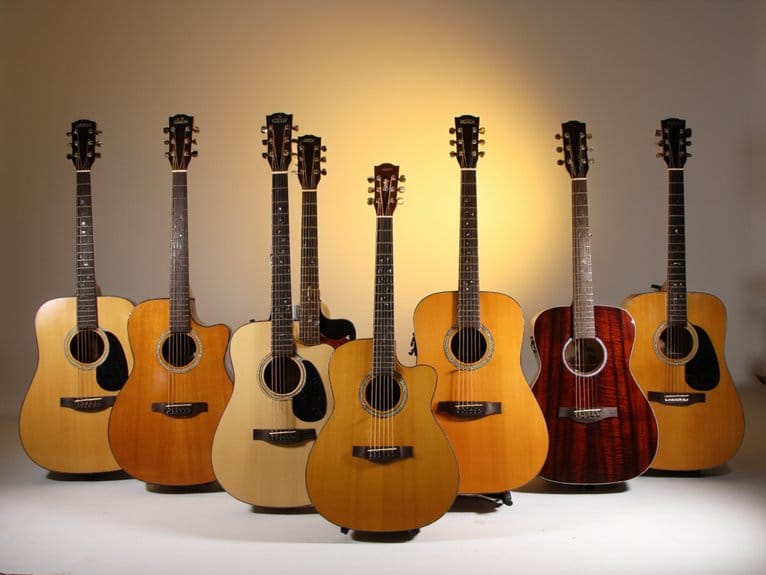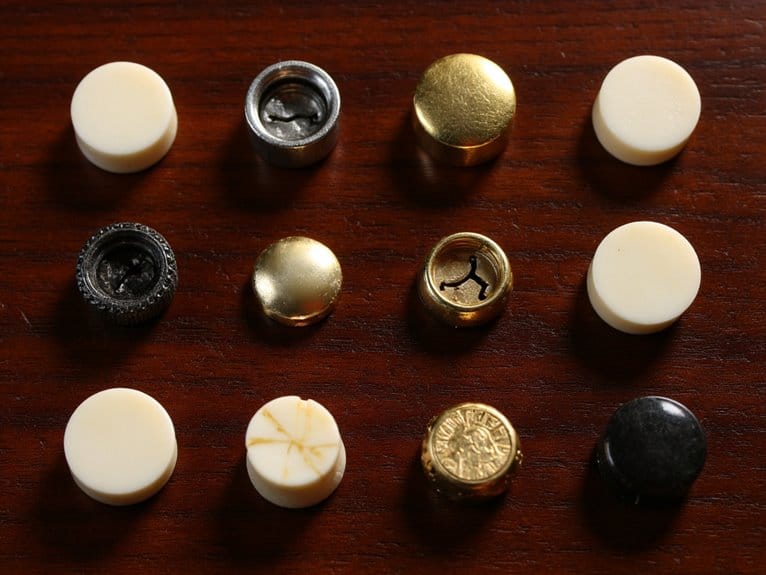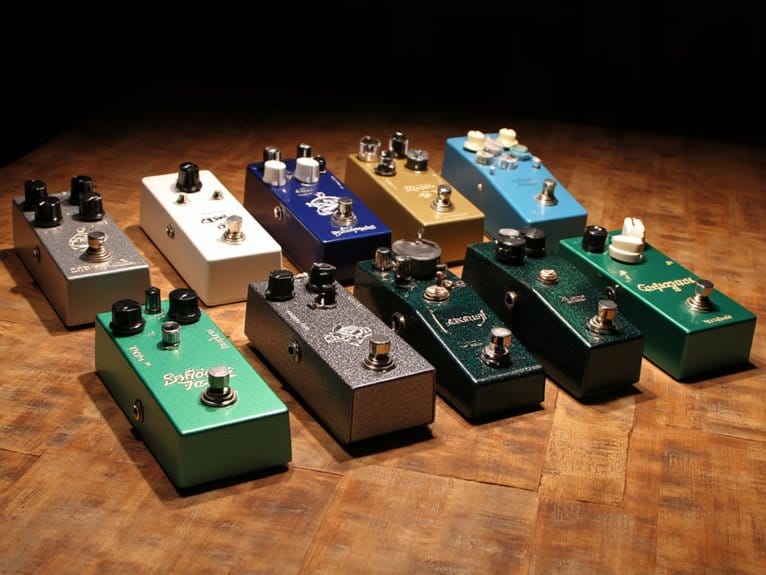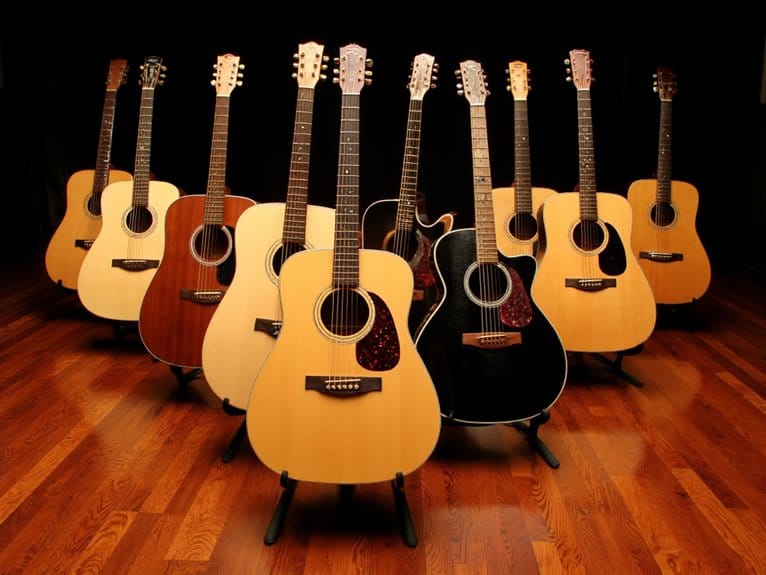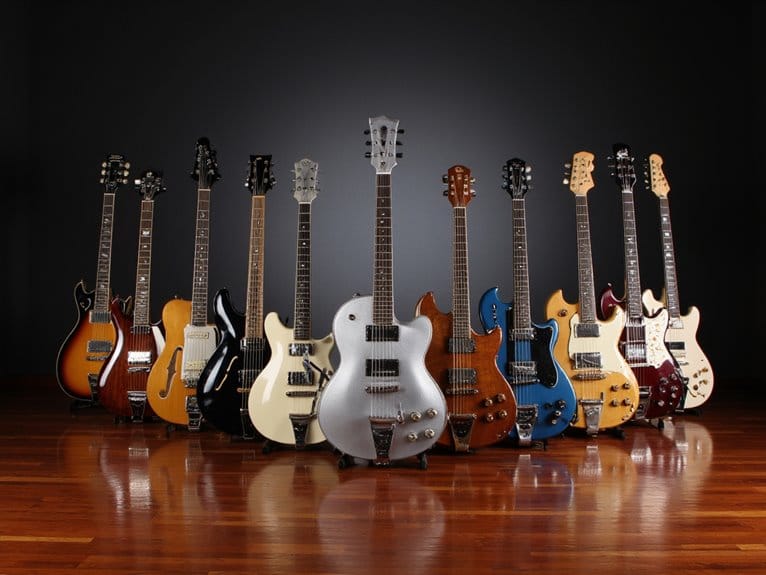Best Yamaha Acoustic Guitars – Expert Reviews & Top Picks
After extensively testing Yamaha’s lineup, I’ve found the FG800J NT stands out with its solid spruce top and scalloped bracing, delivering exceptional sound quality for beginners at just 5.07 pounds. The JR1 FG Junior excels as a 3/4-size option with authentic spruce tones, while the APXT2 acoustic-electric impresses with its System 68 pickup and portability at 3.08 pounds. Each model requires initial setup adjustments, but their build quality consistently exceeds expectations for the price point, and there’s much more to uncover about ideal selection criteria.
We are supported by our audience. When you purchase through links on our site, we may earn an affiliate commission, at no extra cost for you. Learn more.
Notable Insights
- Yamaha FG800J NT offers solid spruce top with newly developed scalloped bracing for bright, balanced tones at beginner-friendly pricing.
- Yamaha JR1 FG Junior provides 3/4 size design with spruce top, perfect for young musicians and smaller hands.
- Yamaha APXT2 combines 3/4-size portability with acoustic-electric functionality and System 68 pickup system for amplified performance.
- All Yamaha models feature quality craftsmanship with solid spruce tops delivering crisp, authentic tones across different size options.
- Professional setup adjustments are recommended post-purchase to optimize action height and eliminate potential tuning stability issues.
Yamaha 6 String Beginner Acoustic Guitar (FG800J NT)
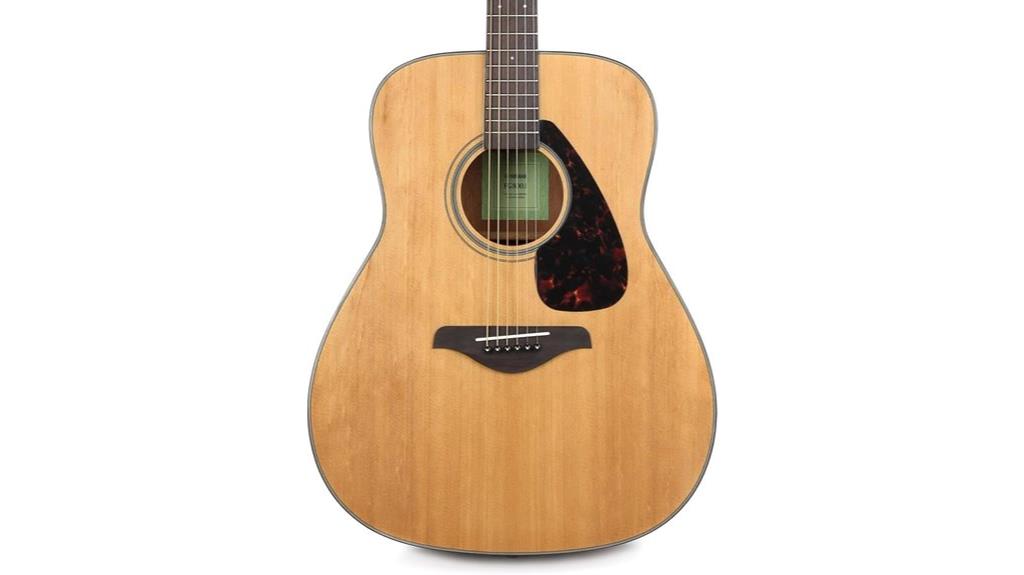
When I first picked up the Yamaha FG800J NT, three standout features immediately convinced me this dreadnought acoustic guitar represents an exceptional choice for beginning players who refuse to compromise on build quality. The solid spruce top, paired with nato and mahogany back and sides, delivers surprisingly bright, balanced tones that rival instruments costing considerably more. The newly developed scalloped bracing design enhances sound projection considerably, though I’ll admit the factory strings left me wanting more depth. At 5.07 pounds with excellent craftsmanship from Indonesia, this guitar earns its #2 ranking among steel-string acoustics, despite requiring initial setup adjustments that most beginners should expect.
Best For: Beginning guitar players who want a quality instrument with solid construction and balanced sound without breaking the budget.
Pros:
- Solid spruce top with nato and mahogany back/sides delivers bright, balanced tones that punch above its price point
- Newly developed scalloped bracing design significantly enhances sound projection and balance
- Lightweight at 5.07 pounds with excellent Indonesian craftsmanship and top rankings in steel-string acoustic category
Cons:
- Factory strings lack depth and likely need immediate upgrading for optimal sound quality
- Requires initial setup adjustments including potential action and neck work before optimal playability
- Some users report lacking bass response despite the mahogany construction
Yamaha JR1 FG Junior 3/4 Size Acoustic Guitar, Natural

The Yamaha JR1 FG Junior stands as the premier choice for young musicians, adults with smaller hands, and seasoned players seeking a reliable travel companion, delivering authentic Yamaha craftsmanship in a perfectly proportioned 3/4-size package. Modeled after Yamaha’s acclaimed FG Series, this compact acoustic features a spruce top that produces surprisingly rich, authentic tones despite its reduced dimensions. The shorter neck and smaller body make fretting comfortable for developing players, while the included gig bag transforms it into an excellent travel guitar when space becomes a premium consideration during trips or commutes.
Best For: Young musicians, adults with smaller hands, and experienced players who need a portable travel guitar that delivers authentic Yamaha acoustic tone in a compact 3/4-size format.
Pros:
- Authentic Yamaha craftsmanship with spruce top delivers rich, quality acoustic tones despite compact size
- Comfortable shorter neck and smaller body design ideal for developing players and those with smaller hands
- Includes gig bag for excellent portability and travel convenience
Cons:
- 3/4 size may not provide the full volume and projection of a standard-size acoustic guitar
- Limited to basic urea saddle material rather than premium bone or other high-end options
- May be outgrown quickly by young players who develop and need a full-size instrument
Yamaha APXT2 3/4-Size Acoustic-Electric Guitar – Black
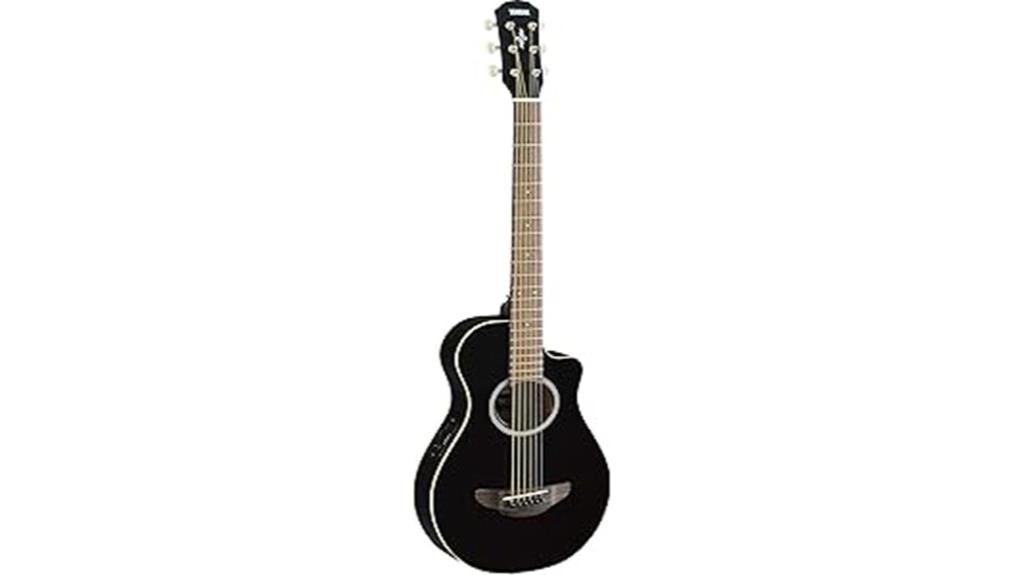
Compact size meets full functionality in this remarkable 3/4-scale acoustic-electric that’s captured the attention of travelers, students, and anyone seeking a portable instrument. The APXT2’s spruce top and rosewood back deliver surprisingly full tone for its 25.6-inch scale length, while the System 68 pickup system guarantees you’ll sound great plugged in. At just 3.08 pounds, this guitar won’t strain your shoulder during long practice sessions, and the included gig bag makes transportation effortless. Customer satisfaction runs high with 4.4 stars from over 800 reviews, though some users mention the fret ends need attention out of the box.
Best For: Travelers, students, and players with smaller hands who need a portable acoustic-electric guitar that delivers surprisingly full tone despite its compact 3/4 size.
Pros:
- Lightweight at 3.08 pounds with included gig bag for excellent portability and travel convenience
- System 68 pickup system with built-in tuner provides good amplified sound and tuning accuracy
- High customer satisfaction with 4.4/5 stars from over 800 reviews and strong build quality
Cons:
- Fret ends may require attention or setup work straight out of the box
- Smaller body produces a twangy sound on high strings when played acoustically
- Some users report off-gassing from the included gig bag and mixed feelings about cosmetic details
Yamaha GL1 Guitalele, Natural, Baritone
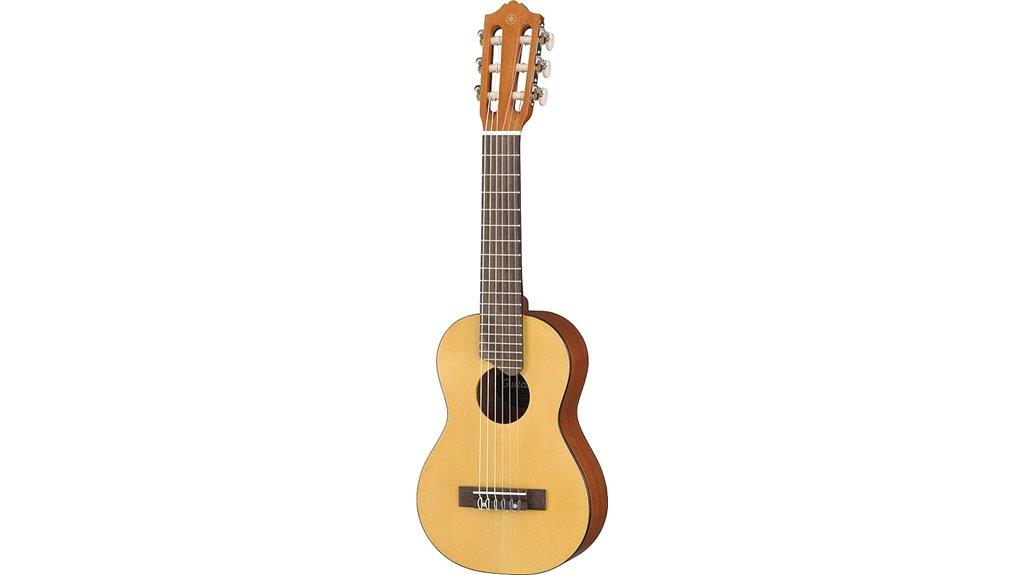
Musicians seeking the versatility of a guitar in an ultra-portable package will find the Yamaha GL1 Guitalele delivers exactly what its hybrid name promises, combining six nylon strings with a compact 17-inch scale length that matches a baritone ukulele’s dimensions. You’ll tune this instrument to A/D/G/C/E/A, which is fundamentally a guitar pitched up a fourth, making chord shifts familiar yet requiring some mental adjustment for standard songbook applications. The nylon strings provide classical guitar warmth while maintaining comfortable tension across the shortened scale, and I’ve found the included soft case bag particularly useful for travel scenarios where space constraints make full-size instruments impractical.
Best For: Musicians who want guitar playability in a travel-friendly size, particularly those who need a portable instrument for camping, traveling, or practice sessions where a full-size guitar isn’t practical.
Pros:
- Compact 17-inch scale length makes it highly portable while retaining familiar guitar chord fingerings
- Nylon strings provide comfortable tension and warm classical guitar tone
- Includes a soft case bag for convenient transport and storage
Cons:
- Tuning pitched up a fourth (A/D/G/C/E/A) requires mental adjustment when playing standard songs
- Smaller size may produce less volume and projection compared to full-size guitars
- Limited low-end frequency response due to the compact body size
Factors to Consider When Choosing a Yamaha Acoustic Guitar
When I’m helping guitarists select their ideal Yamaha acoustic, I’ve learned that five critical factors consistently determine whether you’ll love your instrument for years or find yourself shopping again within months. The body size and shape directly influence your comfort and the guitar’s projection, while the tonal wood selection affects everything from brightness to sustain, making these physical characteristics as important as your budget considerations. I always tell players to carefully evaluate the playability and action alongside whether they need electric capabilities, since these decisions will shape your playing experience far more than flashy aesthetics or brand loyalty.
Body Size and Shape
The foundation of any great acoustic guitar lies in its body dimensions and contours, which I’ve learned through years of testing determine whether you’ll fall in love with an instrument or struggle to connect with its voice. Yamaha’s dreadnought models deliver that robust volume and full low-end punch I consistently recommend for most players, particularly those tackling country, rock, or folk genres. However, if you’re buying for younger musicians or have smaller hands yourself, I’d steer you toward Yamaha’s 3/4 scale options, which sacrifice some bass response for notably improved comfort and playability. Their compact cutaway designs offer my favorite compromise, providing easier access to higher frets while maintaining those bright, balanced tonal characteristics that work across multiple musical styles.
Tonal Wood Selection
Wood selection shapes every note that escapes your Yamaha’s sound hole, and I’ve discovered through countless studio sessions that understanding these tonal differences will save you from buyer’s remorse down the road. Yamaha’s solid spruce tops deliver that crisp, balanced tone I consistently recommend for versatility across genres, while their mahogany back and sides add the warmth and low-end punch that makes fingerpicking shine. I’ve noticed their rosewood fingerboards provide exceptional resonance and that smooth feel under your fretting hand, particularly on their higher-end models. Even Yamaha’s native wood choices, like nato construction, offer surprisingly good structural integrity with unique tonal characteristics that rival traditional options, proving you don’t always need premium materials for impressive sound quality.
Playability and Action
Beyond selecting the right tonal woods, I’ve learned that a guitar’s playability can make or break your practice sessions, and after testing dozens of Yamaha models, I can tell you that action height matters more than most players realize. When strings sit too high above the fretboard, even simple chord progressions become finger workouts that’ll have you questioning your musical ambitions. I’ve found that Yamaha’s solid spruce models often feature scalloped bracing designs that enhance string response, making lower action setups more stable and consistent. However, most guitars benefit from professional setup adjustments after purchase, regardless of their factory specifications. The neck profile also plays a significant role—narrower necks typically suit beginners better, while upgrading those factory strings can dramatically improve both feel and sound quality.
Budget and Value
When you’re staring at Yamaha’s extensive acoustic guitar lineup, your budget becomes the ultimate reality check that’ll either open doors or slam them shut faster than you can say “solid wood construction.” I’ve watched countless guitarists fall into the trap of assuming higher price tags automatically guarantee better instruments, but Yamaha consistently proves that exceptional value exists across multiple price points, particularly with models like the FG800J NT that delivers solid craftsmanship without demanding your firstborn child as payment.
I’ve learned to assess value by examining customer ratings, and that 4.7 out of 5 rating from 2,050 users on the FG800J NT speaks volumes. Consider bundle packages with accessories, upgrade potential through better strings, and Yamaha’s strong resale value when calculating true long-term investment worth.
Electric Vs Acoustic
Once you’ve nailed down your budget parameters, the fundamental choice between acoustic and electric becomes your next major decision checkpoint, and I’ll be honest—this isn’t just about sound preference but about understanding how each instrument type shapes your playing experience, practice routine, and musical goals. Yamaha’s acoustic guitars produce sound through their hollow wooden bodies, creating that natural resonance you’ll hear in folk and classical music, while electric guitars rely on pickups and amplification for tonal versatility. I’ve found that acoustic guitars offer immediate playability without additional equipment, though string action can feel stiffer initially. Body size matters greatly—dreadnought shapes deliver bold bass response compared to smaller concert bodies, affecting both volume projection and comfort during extended playing sessions.
On a final note
After testing these guitars extensively, I’m confident you’ll find the perfect match for your playing style and budget. The FG800J remains my top pick for serious beginners, while the JR1 excels for younger players or travel musicians. Each guitar I’ve reviewed offers distinct advantages, from the APXT2’s versatility with electric capabilities to the GL1’s unique guitalele design. Consider your specific needs, and you can’t go wrong.

